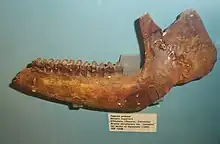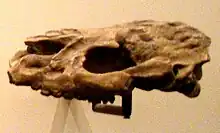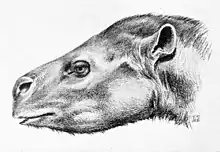Protapirus
Protapirus (Latin: "before" (pro), + Brazilian Indian: "tapir" (tapira)[1]) is an extinct genus of tapir known from the Oligocene and Miocene of North America and Eurasia.[2]
| Protapirus | |
|---|---|
 | |
| Mandible of Protapirus priscus | |
| Scientific classification | |
| Domain: | Eukaryota |
| Kingdom: | Animalia |
| Phylum: | Chordata |
| Class: | Mammalia |
| Order: | Perissodactyla |
| Family: | Tapiridae |
| Genus: | †Protapirus Filhol, 1877 |
| Type species | |
| †Protapirus priscus Filhol, 1874 | |
| Species | |
| |
Taxonomy
The type species is Protapirus priscus from the Late Oligocene of Quercy, France.[3] Protapirus is often considered the earliest true tapir, or at least a tapiroid that is the direct ancestor of the true tapir family.[4]
Distribution and history

The oldest species is the North American P. simplex from the White River Formation. A later North American species is P. obliquidens From North America, the genus spread into Eurasia during the Oligocene,[5] with five species known from the Oligocene and Miocene of Europe and a single species (P. gromovae) from Kazakhstan.[6]
Description

They were of similar size to modern tapirs, but had more primitive features, such as premolars that were less molariform in shape. In comparison to more primitive tapiroids, Protapirus had retracted nasal region which may indicate the presence of a trunk.[7] However, the nasals were not as shortened as in modern tapirs, so the proboscis would have likely been less prominent.[8]
References
- "Glossary. American Museum of Natural History". Archived from the original on 20 November 2021.
- The Paleobiology Database
- Cerdeño, E.; Ginsburg, L. (1988). "European Oligocene and early Miocene Tapiridae (Perissodactyla, Mammalia)". Annales de Paléontologie. 74 (2): 71–96.
- Stanley, S.M. (2012). Living Fossils. Springer New York. ISBN 9781461382713.
- Journal of Vertebrate Paleontology. 18 (1–2). 1998.
{{cite journal}}: Missing or empty|title=(help) - Bayshashov, Bolat U. (2011). "Records of TAPIROIDEA GRAY, 1825 (Mammalia, Perissodactyla) from KAZAKHSTAN – AN OVERVIEW". Acta Palaeontologica Romaniae. 7: 1–7.
- Agustí, Jordi; Antón, Mauricio (2002). Mammoths, Sabertooths, and Hominids: 65 Million Years of Mammalian Evolution in Europe. Columbia University Press. p. 91. ISBN 9780231116411.
- Benton, Rachel C. (2015). The White River Badlands: Geology and Paleontology. Indiana University Press. p. 156. ISBN 9780253016089.